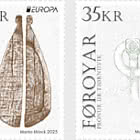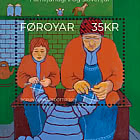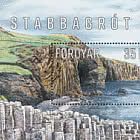- Home
- Stamps
- Faroe Islands
- 2023
Salt - Sound Art Live Theatre
Suðuroy is the southernmost island in the Faroe Islands which is unique both culturally and geologically. The inhabitants have their own dialect, and a special sense of humour, and their island fascinates people with its beauty.
Suðuroy also has a cultural centre that differs from other cultural centres. This is the old Salt Silo, which has been converted into a music, theatre and culture establishment called SALT, which today stands for Sound, Art Live Theatre. The Silo was originally built in 1937-38 and has now been reconstructed into a modern cultural building, creating the framework for a rich and dynamic cultural life in Suðuroy. Although it is a modern building with modern facilities and cutting-edge sustainable heating and cooling systems that are 100% green, 75% of the old building still stands.
This building stands out from other buildings in the Faroese landscape. Unfortunately, we do not know the name of the original architect. Still, we know that he was a Frenchman and that the French company Compagnie Commerciale des Sels Marins commissioned the premises. The company still exists and was responsible for most of the salt production in Europe when the Salt Silo was built.
Since the reconstruction of the cultural centre SALT started, we have tried to find out more about the French architect who designed the building, but unfortunately, without success. Perhaps some alert stamp collector can conjecture the architect's identity, at least the one who came up with the idea of this structure which is unique and inspiring structure inside and out. The interior is awe-inspiring with its original, light and elegant steel and concrete arches that leave their distinctive mark on the building and tell an extraordinary story connecting past and present.
This large industrial building was built in the Faroe Islands in the 1930s because the Faroese fishing fleet grew so much during this period that the increased demand for salt required a more extensive and modern salt depot. The French planned to build more salt silos in the North Atlantic, e.g., Iceland and Norway but abandoned these plans due to the Second World War. Which is why the salt silo at Drelnes in Suðuroy is today the only one of its kind and the purest example. However, other silos still resemble this one, e.g., in Italy, Liverpool and Casablanca. We have also understood that there are plans to renovate some of those buildings into cultural centers or for similar purposes. If there are any stamp collectors who know more about this, we would very much like to hear from them.
When the work to renovate the Salt Silo began, it was more of a ruin than anything else. But the ruins were beautiful, even poetic so to speak, which told a tale of a structure built by living hands. Today the Salt Silo is a living building with many and diverse cultural activities. One of the major challenges of the renovation was the acoustics and the need to create a good sound reproduction in a large facility where sound panels and parabolas had to work together. With good acoustic advice from Denmark, Japan and France, it has been possible to create a concert venue with a high acoustic level. This is an advantage, not only for concerts, but also in everyday life, where good acoustics should create intimacy and a calm, friendly atmosphere when people talk together.
SALT is proud to invite all guests, both foreigners and Faroese, to Suðuroy to experience a very special island and a special building that has contributed so much to the island's cultural life. One of the best examples of this is the Suðuroy Theatre Company, which has found its scenic setting in SALT. Suðuroy Theatre Company was founded in SALT and has, in a few years, become one of the most active theatre groups in the Faroe Islands. Seeing how pioneers can create opportunities when appropriate cultural settings are created is beautiful and inspiring.
Finally, we must mention that the architects behind the renovation of the building were Albert Isfeldt, an architect from Tórshavn, and C.F. Møller Architects from Aarhus, Denmark.
A.P. Møller Foundation, the Faroe Islands Parliament and the Danish state financed the construction of SALT, while the Faroe Islands government and Tvøroyri municipality financed the operation.
Ólavur Rasmussen
Faroe Islands - Recommended stamp issues
WOPA+ recommended stamp issues
| Avatar - Fire and Ash |
| Issued: 03.12.2025 |
| ›New Zealand |
| 50th Anniversary of the Founding of the 24th November Bar Scout |
| Issued: 24.11.2025 |
| ›Montenegro |
| Krisjanis Valdemars |
| Issued: 02.12.2025 |
| ›Latvia |
| Sign Language - Good |
| Issued: 02.12.2025 |
| ›Bosnia and Herzegovina - Republic of Srpska |
| In Memory of the Fallen and Murdered on October 7, 2023 |
| Issued: 08.10.2025 |
| ›Israel |
| Annual Collection Folder (New York) |
| Issued: 05.12.2025 |
| ›United Nations |
| Year Set |
| Issued: 24.11.2025 |
| ›Isle of Man |
| Shipping in the 17th and 18th Centuries - Peat Shipping |
| Issued: 05.12.2025 |
| ›Netherlands |











































